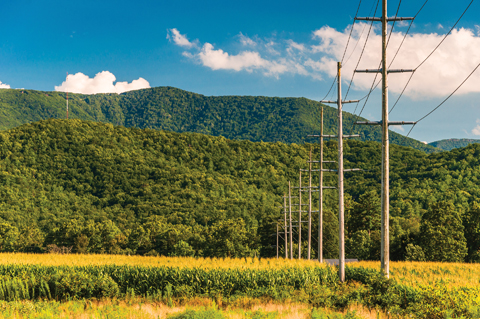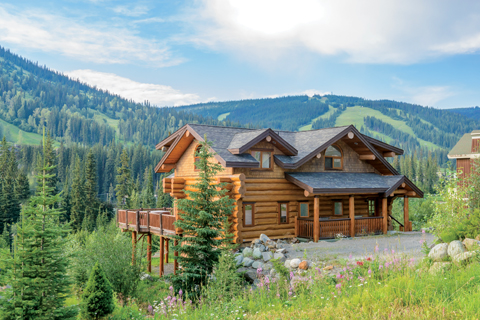Building a log or timber home in a rural area and/or on undeveloped land can present a unique set of challenges that most other homeowners don’t have to manage. Even if you’ve already selected the perfect plot of land for your new abode, there are certain considerations that must be factored in before moving forward with the site preparation and the actual home construction.
If you haven’t found the right place yet, on the other hand, you’ll want to find a real estate broker who knows the intricacies of the various land opportunities in your target area (i.e., a local broker with years of experience—and preferably with at least some log/timber homeowners). The broker will help you navigate any rules and regulations (i.e., where log homes are permitted … or not); the land’s history and how it’s been used over time; any potential issues, such as land boundaries; the plot plan; and all codes/environmental impact issues.
During this process, your log or timber package provider and builder can also help identify any potential issues and point you in the right direction when it comes to overcoming challenges and/or making the correct decisions. At Pioneer Log Homes in Victor, Montana, for example, Manager Rob Ridgway says one of the first issues homeowners should consider when selecting land is the actual slope of the property.
Defined as the “steepness” of a surface, slope is expressed in rise and run (the ratio of vertical increase to the horizontal span) or in degrees or percentages. Ridgway advises owners to seek out areas where the slope is as low as possible to avoid future problems with access and construction. “Slope can be integral when it comes to accessing your future home site,” says Ridgway. “Where it may be easy to drive a Jeep up to your new site, getting equipment onto the land, building a road to it, and then constructing a home there could turn out to be quite a challenge.”

Jon Bilous
Special Considerations
Factoring issues like the slope of your land into the selection and development process can help owners ward off potential cost overruns—such as those that rear their ugly heads when it takes more time, materials, and labor than expected to build a road to the site itself. “We’ve run into a number of folks who have purchased a beautiful piece of ground, only to find out that a large portion of their $800,000 budget is going to be spent on road construction,” says Ridgway, who advises owners to get their log/timber home providers involved in the process as early as possible. A firm that’s familiar with the area where the land is located, for example, can provide a level of pre-construction expertise that helps owners avoid costly decisions and even mistakes.
“A reliable log home provider can be instrumental in the site selection and development process, particularly if it has a long-standing reputation in the log and/or timber home community in the area,” Ridgway states. “That company can even help you pick out the right general contractor, architect, and others who will play key roles in bringing your home from concept to completion.”
Access to power is another key consideration when building on undeveloped land, says Ridgway. Don’t want overhead power lines going straight up your hill and ruining your beautiful view of the lake? Then those lines will have to be buried in the ground alongside your driveway. If that driveway is a quarter-of-a-mile long, the cost of burying the lines could be considerable.
The same amount of mindshare should be given to the cost of water, sewer, well, and/or septic infrastructure, says Ridgway, who has seen many owners come up with a “total cost” that doesn’t include these line items. “Most of the time people look at a total investment cost after buying their land, period,” says Ridgway. “In reality, the total land cost alone should include the land, driveway, well and septic, and power. That’s the true cost of the land. The home, at $200-$300 per square foot, comes in on top of that.”

Earl D. Walker
Risk Management from Afar
At Blue Ridge Log Cabins in Campobello, South Carolina, Freddie Jones, business development manager, says owners who are building in areas that they aren’t familiar with (such as out-of-state homeowners who reside elsewhere), should pay particular attention to the intricacies of constructing on rural or undeveloped land. “Risk management becomes tricky when you can’t be onsite regularly … or at all,” says Jones. “When you’re hundreds or more miles away, supervising the site development and construction can be especially challenging.”
To avoid such issues, Jones says owners should try to match up the land itself with their desired home style and structure. A Baby Boomer couple who are close to retirement age and are looking for a single-floor log or timber home should closely consider exactly how their home’s design aligns with the buildable areas of the plot. On the other hand, a multi-level house will require a different base and foundation that, according to Jones, will need to be accommodated on the physical land. “Look at the buildability of the land,” says Jones, “and how well it matches with the home that you want to construct.”
Finally, Jones says homeowners should be able to completely trust and rely on their builders—and again, particularly when onsite visits aren’t always feasible. “Vet out the list of available builders and find one that you can really work with and rely on,” Jones advises. “When you’re hundreds of miles away and relying on someone else to complete your project within your parameters and to your specifications, a good builder can really mean the difference between success and failure.”
by Bridget McCreace

